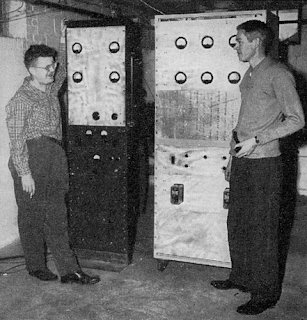Serving the worldwide community of radio-electronic homebrewers. Providing blog support to the SolderSmoke podcast: http://soldersmoke.com
Podcasting since 2005! Listen to our latest pocast here:
Podcasting since 2005! Listen to Latest SolderSmoke
Friday, November 8, 2013
Knack-to-the-Max! Early Moonbounce
The link below will take you to an amazing collection of QST articles describing the early days of EME or "moonbounce." Very interesting. I was really blown away when I found out that Ross Bateman, W4AO, (pictured above, on the left) did the very first amateur moonbounce work from the small suburban Washington town that I live in now -- Falls Church, Virginia!
I am trying to find OM Ross's old address or more info about him. If anyone has an old callbook, could you please look up Ross Bateman, W4AO, aka W4XNB? He worked at the National Bureau of Standards.
The moonbounce story is filled with interesting technology and characters and clubs. Sam Harris and his Rhododendron Swamp VHF Society sounds like our kind of group! Scroll through the OK2KKW web site and you will come across our esteemed Doug DeMaw and Bill Orr.
http://www.ok2kkw.com/eme1960/eme1960eng.htm
Our book: "SolderSmoke -- Global Adventures in Wireless Electronics" http://soldersmoke.com/book.htm Our coffee mugs, T-Shirts, bumper stickers: http://www.cafepress.com/SolderSmoke Our Book Store: http://astore.amazon.com/contracross-20
Subscribe to:
Post Comments (Atom)

Of course, before Doug DeMaw worked at the ARRL, he had a small company making VHF eqipment. The company name escapes me now, but it was sold or terminated when he moved to the ARRL. For a while, he published a magazine, I think it was the VHFer, via the company.
ReplyDeleteBut his interest either disappeared when he moved to the ARRL, or he was expected to deal with HF, because his work there didn't reflect his earlier interest in VHF.
Sam Harris is credited with making the first practical parametric amplifier, which I've always read to mean that someone else had come up with the idea, but he was the first one to make it work. He had an article in CQ about 1958 which has to be the first ham article on the amplifiers. And after showing how to do it, the need for a varactor came up. He bsically ended the article with some suggestions, basically saying "get it going with some other semiconductor diode (and he mentioned some ideas) and then when you're ready, a real varactor shouldn't be a problem". He was working at Microwave Associates then which made varactors, and seemed to be offering them to anyone who got far enough along.
And that page is a deep contrast to the trendy "Makers". We know so little about people like Sam Harris or Hank Cross (I'm not sure I've ever seen a photo of him before), or Dana Achtly, but they were so important. Not just about moonbounce, but Hank Cross wrote a lot about receivers. We didn't need to know who they worked for, or what their professional job was, their interest in amateur radio was deep, and their writing and innovation was because they were hams. Of course, decades later, they don't get the coverage they deserve, bcause we really don't know what official role Sam Harris had at Arecibo, or what Hank Cross did professionally.
Another important contrast is that all those articles about moonbounce (and various articles about under the noise reception) and a three part article in QST about parametric amplifiers, they wre all in the mainstream amateur magazines. QST, and then Ham Radio, even 73. We knew these guys were doing interesting things because they were covered int he mainstream ham magazines. Whether or not the readers cared, or even read the articles, at least they had access to them. Now, such technical articles wold be vanquished to QEX unless it was a project many would be interested in, and I'm sure VHF work is now relegated to specialized publications. If you don't stumble on it, you'll never know it exists.
The same can be said for amateur radio itself, it's been a long time since I saw mention in the local paper. Yet, I learned about amateur radio when I was 9 years old when there was an article about AM Dxing in a magazine for Scouting in Canada, and then a followup letter mentioned ham radio. Amateur radio would get occasional mention in the papers, and at least if you were interested in hobby electronics, you'd learn about shortwave listening and amateur radio because they were covered there too.
It is way easier to find information once you know about some specialized hobby nowadays, but a lot less likely for people to find out about those hobbies in the first place.
Michael VE2BVW
I noticed that Ross Bateman was also pretty high up in National Bureau of Standards CRPL according to a couple references I found. He was actually trying moonbounce there too!
ReplyDeletehttp://history.nasa.gov/SP-4218/ch1.htm
and
http://www.ieeeghn.org/wiki/index.php/James_M._Watts